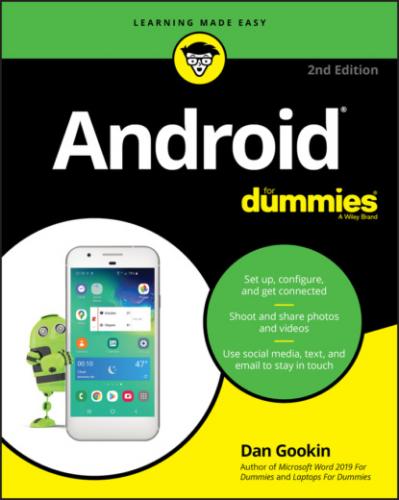Beyond my own website (see the preceding section), my beloved publisher also offers its own helpful site, which contains official updates and bonus information I’m forbidden by law to offer to you. Visit the publisher’s official support page at www.dummies.com and then search for Android For Dummies, 2nd Edition — the whole thing! I’d offer more specific information, but I don’t have it. The publisher told me that the actual address of the online material is held in one of 20 briefcases and that if I choose the right one, I get paid — something like that.
Your task now: Start reading the rest of the book — but not the whole thing, and especially not with the chapters in order. Observe the table of contents and find something that interests you. Or look up your puzzle in the index. When these suggestions don’t cut it, just start reading Chapter 1.
Enjoy this book and your Android mobile gizmo!
Part 1
Your Own Android
IN THIS PART …
Get started with your Android gizmo.
Work through configuration and setup.
Learn basic techniques and procedures.
Force yourself to enjoy the onscreen keyboard.
Chapter 1
An Out-of-the-Box Experience
IN THIS CHAPTER
You begin your Android adventure by removing the device from its box. Yes, I know: You’ve already completed that task. I don’t blame you; I removed my new Android from the box before I read this chapter. Yet you may consider a few helpful tips and suggestions before that out-of-the-box experience becomes a distant memory.
Liberation
Like most electronics, your new Android phone works fastest when you remove it from its box. Savor the moment. Breathe deep the scent of the industrial epoxy used to seal the box. Gingerly lift out the packaging. Marvel as you peel back the plastic sheeting.
Array before you the contents of the box. These useful items include
The device itself: If further assembly is required, directions are found inside the box.
USB cable: Use it to connect the device to a computer or a wall charger.
Power adapter: Use this thing with the USB cable to charge the Android’s battery. The adapter may come in two pieces, both of which must be assembled.
Earbud headset: This item might be a simple headset, or you might find a microphone/controller gizmo on one of the earbud leads.
Useless pamphlets: It’s odd that the safety and warranty information is far more extensive than the flimsy user guide. That shows the priority our culture places on lawyers over technology writers.
The SIM card and removal tool: You may find the card holder used to install the device’s SIM card. If the SIM has already been installed, you can toss the holder, though I recommend keeping the SIM card removal tool.
ANDROID BUYING TIPS
The major things to look for when purchasing an Android gizmo are its cellular provider, storage, camera options, screen size, and overall design.
All phones have a cellular connection, but only some Android tablets use this feature. Most tablets use only the Wi-Fi connection for Internet access, which is fine. Cellular or LTE (Long-Term Evolution) tablets cost more and also incur monthly mobile data charges.
Some Androids feature removable storage, in the form of a microSD card. This feature allows you to expand the device’s storage and more easily share files with a computer, though using removable storage isn’t without its issues. See Chapter 19.
The device’s camera has a maximum resolution, measured in megapixels (MP). The higher the value, the better the camera, though unless you plan to edit high resolution images, a zillion megapixels isn’t worth the extra cost. Ensure that an Android tablet has both front and rear cameras. And confirm that the rear camera has a flash. It’s not an important feature, but it’s best to know before you buy the device.
Both screen size and design play together — specifically, with how the device feels in your hand. Some large format phones, often called phablets (for phone/tablets) are too big for some people — and pockets. Tablets come in two sizes: a smaller format, about the size of a paperback book, and a larger format, better suited for watching videos. The best way to know which size works best for you is to try out a few devices at the store.
Beyond these basic items, Android phones and tablets have only subtle software differences. Do ensure, however, that your device can access and use Google Play, the online store for the Android operating system. Some bargain phones and tablets restrict your purchases to the manufacturer’s own app store. I would avoid those gizmos.
The important thing to do is confirm that nothing is missing or damaged. Ensure that you have all the parts you paid for, including any optional accessories. If anything is missing or appears to be damaged, immediately contact the folks who sold you the device.
I recommend keeping the packaging and its contents as long as you own the Android: The box makes an excellent storage place for that stuff — as well as for anything else you don’t plan to use right away.
The process of transferring information from your old phone to a new one is covered in Chapter 2.
Android Assembly
Android devices come fully assembled. If not, directions that came with the device describe what to do. Even then, odds are that the nice people at the store assembled the gizmo for you. If not, well then, they weren’t so nice, were they?
Peeling off the plastic sheeting
Like laser blasters and time travel pods, your Android ships with a clingy plastic sheeting adhering to its surface. The sheeting might describe various features, so look it over before you peel it off. And, yes, you must remove the sheeting; it’s for shipping protection, not for long-term protection.
Check the device’s rear camera to confirm that you’ve removed the plastic sheeting from its lens.
Feel free to discard the plastic
